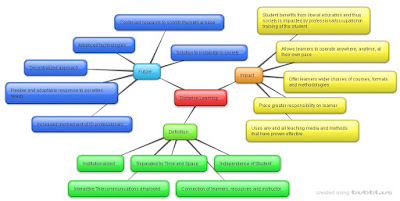Over the past decade, distance
learning has grown in popularity, access, and impact (Simonson, Smaldino, &
Zvacek, 2015). The improvements in and access to technology; education of
instructional designers and instructors; and acceptance and promotion of
distance learning by educational institutions have brought greater visibility to the world of
distance learning than at any other time in history. As society continues to
become more technologically advanced, and institutions (educational and
business) continue to embraces distance learning as a cheaper, equally if not more
effective method of learning, perceptions of distance learning will continue to
grow in positivity.
As an aspiring instructional
designer, I have an influential role in improving the perception of distance
learning due to my ability to create distance learning courses that are
effective (both in educational outcomes and cost) and maintain an equivalent (if
not greater) experience than their face-to-face counterpart (Simonson,
Smaldino, & Zvacek, 2015). Using a strong foundation of theory, mixing
principles of learning and design, and utilizing appropriate technologies
(Laureate Education, n.d.), I can help to maintain and improve the perception that
distance learning courses can be just as effective as face-to-face experiences.
The role of the instructional designer, in both education and business, is to
maintain the integrity and discipline of the profession by adhering to ethical,
theoretical, and pedagogical standards of design, development and delivery.
According to Moller, Foshay, and
Huett, “Distance learning is rapidly becoming a popular choice for continuing
professional education, mid-career degree programs, and lifelong learning of
all kinds” (2008, p. 66) and as society continues to embrace technology this
inclination toward distance learning will only increase as well. As an
instructional designer, I have the ability to embrace and be a positive force
for continuous improvement in the field of distance learning by always
conducting new research, whether it is theory or technology, and ensuring that
my deliverables are of the highest standard.
Working for an education institution
that specializes in online learning, I know first-hand the impact that distance
learning can have in the life of an atypical student. In the future, I want to
embrace what I have learned in this class and apply it to my practice and
deliver exceptional experiences for my learners. I’ve had the unique ability to
explore theories and practices of distance learning; create an entire distance learning
module using a course management system; and analyze how to effectively
facilitate distance learning courses while supporting the diverse and unique
needs of the learners. Although instructional design lends itself to both in
person and distance learning experiences, the exponential growth of distance
learning in the near future that will become integrated in all learning
environments (Laureate Education, n.d.) will certainly present an opportunity
for instructional designers to have a drastic impact on the improvement and societal perception of distance learning.
References
Laureate
Education (Producer). (n.d.). Distance education: The next generation [Video
file]. Retrieved from https://class.waldenu.edu
Laureate
Education (Producer). (n.d.). Theory and distance learning [Video file]. Retrieved
from https://class.waldenu.edu
Moller, L.,
Foshay, W., & Huett, J. (2008b). The evolution of distance education:
Implications for instructional design on the potential of the web (Part 2:
Higher education).TechTrends, 52(4), 66-70
Simonson, M.,
Smaldino, S., & Zvacek, S. (2015). Teaching
and learning at a distance: Foundations of distance education. Information Age Publishing, NC.




